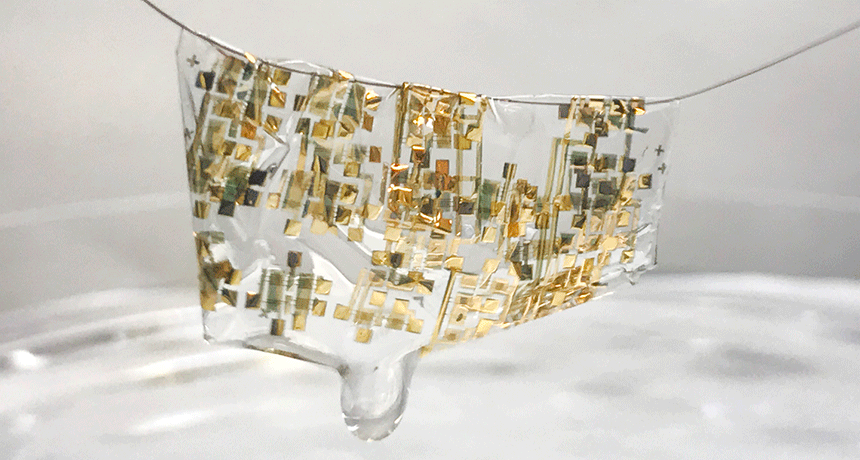Vinegar dissolves new electronics when they’re no longer needed
Components that break down into Earth-friendly materials will leave less electronic waste

A new electronic device is stretchy and light, and dissolves in acid.
Bao Lab/Stanford University
Share this:
- Share via email (Opens in new window) Email
- Click to share on Facebook (Opens in new window) Facebook
- Click to share on X (Opens in new window) X
- Click to share on Pinterest (Opens in new window) Pinterest
- Click to share on Reddit (Opens in new window) Reddit
- Share to Google Classroom (Opens in new window) Google Classroom
- Click to print (Opens in new window) Print
Engineers have built a new type of gadget that doesn’t look like most others. It’s stretchy, thin and so light that a human hair can lift it. It’s made from cheap, nontoxic materials. It can also vanish. After a month in acid — even just kitchen vinegar — the device is gone.
Chemical engineer Ting Lei helped design the innovation. He works in the lab of engineer Zhenan Bao at Stanford University in California. “We’re focusing on low-cost sensors for flexible electronics,” Lei says. For about five years, Bao’s group has been studying materials that can break down naturally.
The researchers see many uses for such a technology. For example, scientists could build sensors to measure heat or humidity in remote forests. Many soils are acidic. So when the scientists are done taking measurements, their sensors would fall apart and degrade naturally in the soil. Or doctors could implant medical devices that use this technology into patients. The patients wouldn’t need surgery to remove the devices. Instead, their bodies would simply absorb them.
Huanyu Cheng says this new work shows that it’s possible to make electronics that are less toxic to the environment. He is a materials scientist at Pennsylvania State University in State College. Although he did not work on the new research, he too designs dissolvable devices. Electronic sensors and other devices made this way would be “greener,” Cheng says. By that, he means they would be more friendly to the environment.
Building a dissolvable circuit
To demonstrate the new technology, Lei and his team built a stretchy transistor. A transistor controls the flow of current in electronics. The scientists used iron to build the conducting part of the device. Iron occurs naturally, and it won’t cause harmful pollution when the device breaks down. Iron also is more environmentally friendly than gold, which has been used in other stretchy electronics.
However, building the circuit wasn’t the hard part. The researchers had to find some material that could both hold the circuit together and later fall apart in acid. Many flexible electronic devices rely on polymers. A polymer is a material made from long chains of identical molecules. Because polymers can bend and stretch, they’re perfect for electronics that need to flex.
But Lei and his team didn’t want any old polymer. They wanted one that would dissolve in something as simple as vinegar.
Two years ago, they came up with a recipe. They began making a polymer out of imines (IH-meens). These are chemical compounds held together by double bonds between carbon atoms and nitrogen atoms. The bonds stay strong in water, but fall apart in acid. An imine polymer was perfect for Lei and his team.
The last piece of the puzzle was a material to hold the whole device together. The researchers used cellulose. This is the fibrous stuff in plants and trees (and used to make paper).
The team put all of those pieces together to make the first electronic device that can break down into environmentally friendly components. They introduced their transistor May 16 in Proceedings of the National Academy of Sciences. The researchers also showed that the device could conduct electricity.
Electronics that break down can help solve a growing problem. Worldwide, people add around 41 million metric tons (45 million short tons) of electronic waste to landfills every year. And that amount is growing. But if a device dissolves, it won’t add to the problem.
Lei says you probably won’t see his team’s new technology in phones and laptops. It doesn’t perform as well as the transistors in those devices now. But the technology could work for tools that don’t need much power — like forest sensors or implanted medical devices.
“Our target is focusing on small, low-cost, flexible sensors,” he says.
This is one in a series presenting news on technology and innovation, made possible with generous support from the Lemelson Foundation.







